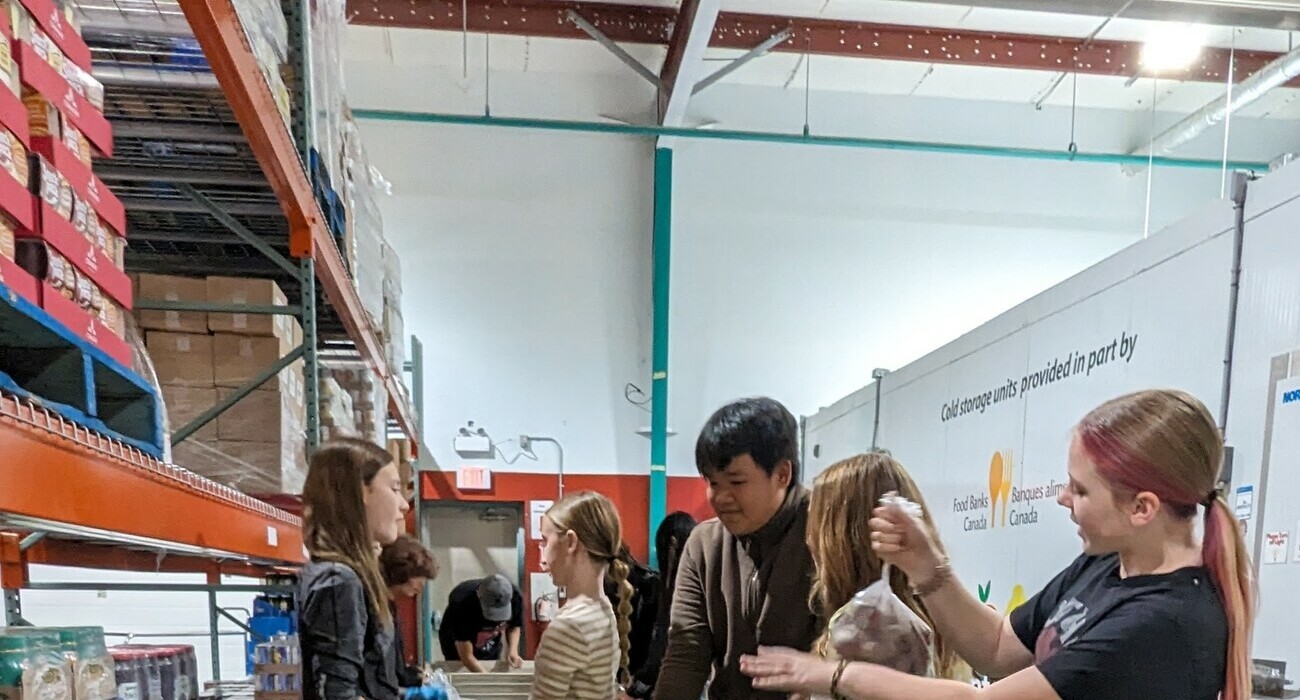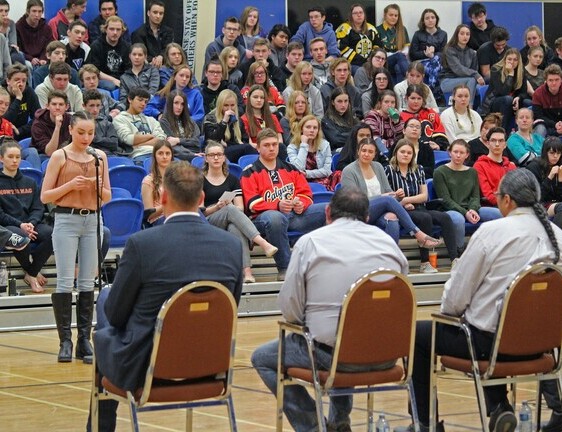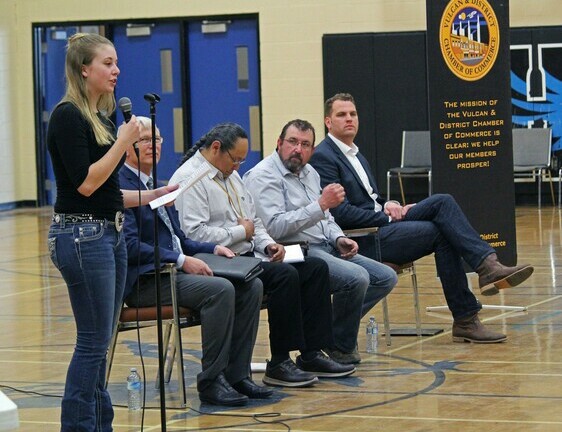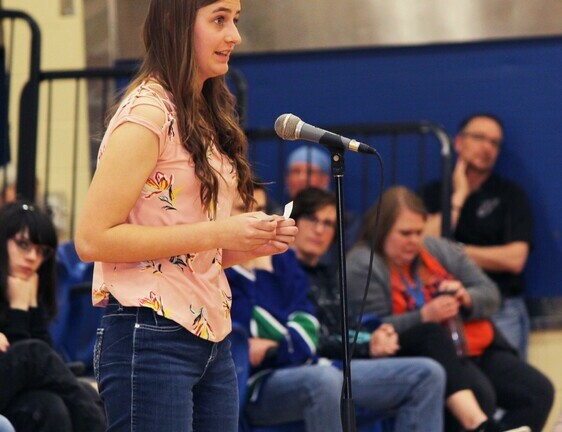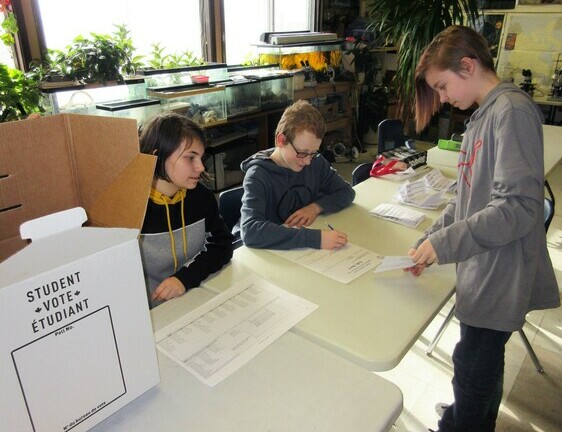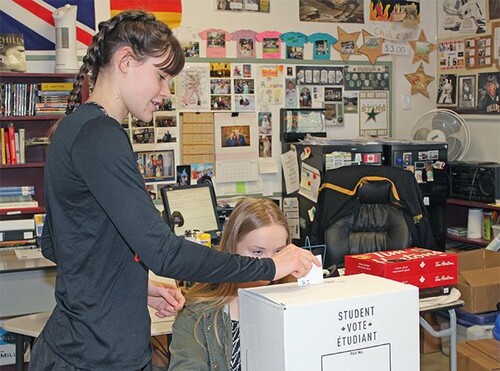
The majority aren’t old enough to vote yet, but don’t assume students in Palliser Regional Schools were disinterested in the provincial election.
A number of schools across Palliser provided students with the opportunity to experience the voting process firsthand through the Student Vote program. Having researched party platforms, the issues and their local candidates, they took on the role of election officers to co-ordinate their own school vote.
At County Central High School in Vulcan, that included organizing a candidate’s forum for the new riding of Cardston-Siksika. Grade 12 student Emily Morse says the event, in which students acted as moderator and formulated thoughtful questions for candidates, was definitely enlightening.
“I believe you can judge a lot about a person by seeing them in person, hearing them speak and how they respond to questions,” says the 17-year-old, who asked candidates about the weighting of diploma marks and frequency of standardized testing. “I walked into that room considering two that might be the best, and I walked out considering a different view.”
The four candidates in attendance fielded questions ranging from their take on farm-safety legislation, to the funding of rural fire departments to ensure prompt response times. Grade 12 student Bailey Steiner sought their views on an issue near and dear to her, the carbon tax.
Not only does it impact her father when fueling up machinery on the family farm, she drives daily to school to avoid a lengthy bus ride. The 18-year-old voted for real just prior to the forum, and says her decision weighed heavily on her own reality.
“It was really what was best for my lifestyle and my family and what I believe is best for the province, because there are definitely some platforms out there that I don’t agree with” says Steiner.
Grade 11 student Alyssa Groves was moderator for the forum, which was hosted by the Vulcan & District Chamber of Commerce. While she had the daunting task of keeping candidates within their allotted time to speak, the 17-year-old says the experience makes her eager to vote once she’s of age.
“I know last election Ian Donovan lost by 10 votes,” says Groves, of the Independent candidate who lost his re-election bid in 2015 while running as a Conservative in the former riding of Little Bow. “It really shows that every vote counts, and it makes me really want to vote.”
The democratic process and associated topics are part of the social studies curriculum for both Grade 9 and 12 students. County Central Principal Leanne Hellman says the forum, which was a total student effort, provided “learning in action.”
“This is a real-life application of what they’ve been learning in social studies class,” she says, adding the intent of Student Vote is to encourage students to ask questions, inform themselves of the issues and the parties running in hopes they’ll cast a ballot for real when it’s their turn.
As his Social 30 class put on a mock election at Coalhurst High School, teacher Michael Saad reflected on his 20th year of involvement with Student Vote.
The issues have changed over the years, he says, with climate change and a proposal to cut minimum wage among the hot topics this time around. The players have changed, with the Alberta Party and Freedom Conservative Party of Alberta among those fielding candidates in Cardston-Siksika. Technology has also allowed for students to get information directly from the candidates, raising the question why votes can’t be cast online.
One constant over the years is the eye-opening realization of the realities of the first-past-the-post voting system.
As a student Saad recalls he too believed he could vote directly for the prime minister. The realization they can only vote for their local Member of Legislative Assembly or Member of Parliament raised questions among his students on the benefits of a change to a proportional representation system.
“I think they want to change the system,” says Saad. “When they have that realization that they don’t get to vote for Justin Trudeau or Rachel Notley or Jason Kenney, it’s like ‘what the heck, why can’t we?’ ”
Adara Hogan was one of his Social 30 students who was tasked with bringing ‘voters’ down to the polling station grade-by-grade. The overall experience should set the 17-year-old up well for the federal election this fall, when she’s “very eager” to vote for the first time.
“I’ve always been interested in voting but it’s kind of fun to run the whole process of Student Vote. I feel like it prepares us for when we actually get to cast a vote,” says Hogan adding she finds such hands-on experience more engaging than reading a textbook.
Casey Hummel’s stint as poll officer during the mock election at Coalhurst High School was a case of role reversal. Earlier, the 18-year-old cast his first-ever ballot at the advance vote for the provincial election.
He appreciated the greater depth of knowledge he received through a combination of his social studies class and the Student Vote process.
“It helped me be more informed than some types of media and what they put out about the parties and what they stand for,” says the Grade 12 student. “It also helped me tie in historical, classical liberalism and the modern liberalism of today.”
Saad noted another constant involving Student Vote, which is run by the non-partisan charity, CIVIX. The votes cast by students usually mirror those of the electorate and this election was no different. Student Vote saw more than 165,000 students from 1,229 schools cast votes with the United Conservative Party (UCP) forming a majority government.
Both Coalhurst High School and County Central High School had the UCP candidate winning the Cardston-Siksika riding. At Coalhurst High School, the UCP earned 46 votes, the NDP 34, the Alberta Party 31, Liberals 15, and both the Freedom Conservative Party and Independent candidate with four each.
Country Central High School students cast 123 votes for the UCP, 20 for the Independent candidate, 13 for Freedom Conservative Party, eight for the Liberals, five for the Alberta Party and three for the NDP.

